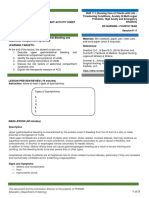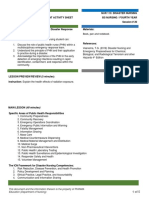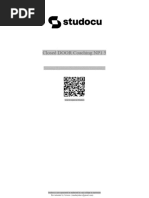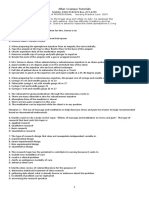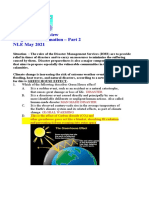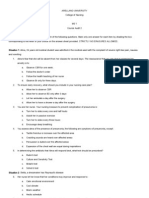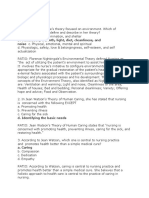Disaster Nursing SAS Session 13
Disaster Nursing SAS Session 13
Uploaded by
Niceniadas CaraballeCopyright:
Available Formats
Disaster Nursing SAS Session 13
Disaster Nursing SAS Session 13
Uploaded by
Niceniadas CaraballeCopyright
Available Formats
Share this document
Did you find this document useful?
Is this content inappropriate?
Copyright:
Available Formats
Disaster Nursing SAS Session 13
Disaster Nursing SAS Session 13
Uploaded by
Niceniadas CaraballeCopyright:
Available Formats
NUR 113: DISASTER NURSING
STUDENT ACTIVITY SHEET BS NURSING / FOURTH YEAR
Session # 13
LESSON TITLE: Mental Health and Psychosocial Support in Materials:
Emergency Settings
Book, pen and notebook
LEARNING OUTCOMES: References:
Upon completion of this lesson, the nursing student can:
Veenema, T.G. (2019) Disaster Nursing and
1. Define MHPSS. Emergency Preparedness for Chemical,
2. Identify problems in emergencies. Biological, and Radiological Terrorism and other
3. State the purpose of MHPSS. Hazards 4th Edition
4. Enumerate the core principles of MHPSS.
5. Discuss the intervention pyramid.
http://icn.ch/IASC_MHPSS_guidelines.pdf
6. Develop an appreciation of the role of the nurse in
providing MHPSS.
LESSON PREVIEW/REVIEW (5 minutes)
Instruction: What are the environmental hazards and their impact?
MAIN LESSON (40 minutes)
Background
The Inter-Agency Standing Committee (IASC) was established in 1992 in response to General Assembly
Resolution 46/182, which called for strengthened coordination of humanitarian assistance.
The resolution set up the IASC as the primary mechanism for facilitating inter-agency decision-making in
response to complex emergencies and natural disasters. The IASC is formed by the heads of a broad
range of UN and non-UN humanitarian organizations.
Objectives of the Guideline
These Guidelines seek to:
enable humanitarian actors to plan, establish and coordinate multi-sectoral responses to protect and
improve people’s mental health and psychosocial well-being in the midst of an emergency.
facilitate an integrated approach to address the most urgent mental health and psychosocial issues in
emergency situations.
The focus of the guidelines is on implementing minimum responses, which are essential, high-priority responses that
should be implemented as soon as possible in an emergency.
Minimum responses: first things that ought to be done; the essential first steps that lay the foundation for
the more comprehensive efforts that may be needed (including during the stabilized phase and early
reconstruction)
Participating Organizations
Action Contre la Faim (ACF)
InterAction (co-chair), through:
• American Red Cross (ARC)
• Christian Children’s Fund (CCF)
• International Catholic Migration Commission (ICMC)
This document and the information thereon is the property of PHINMA
Education (Department of Nursing) 1 of 7
• International Medical Corps (IMC)
• International Rescue Committee (IRC)
• Mercy Corps
• Save the Children USA (SC-USA)
Inter-Agency Network for Education in Emergencies (INEE)
International Council of Voluntary Agencies (ICVA), through:
• ActionAid International
• CARE Austria
• HealthNet-TPO
• Médicos del Mundo (MdM-Spain)
• Médecins Sans Frontières Holland (MSF-Holland)
• Oxfam GB
• Refugees Education Trust (RET)
• Save the Children UK (SC-UK)
International Council of Voluntary Agencies (ICVA), through:
• ActionAid International
• CARE Austria
• HealthNet-TPO
• Médicos del Mundo (MdM-Spain)
• Médecins Sans Frontières Holland (MSF-Holland)
• Oxfam GB
• Refugees Education Trust (RET)
• Save the Children UK (SC-UK)
DEFINITION OF TERMS:
The term “psychosocial” denotes the inter-connection between psychological and social processes and the fact
that each continually interacts with and influences the other.
The composite term mental health and psychosocial support (MHPSS) is used to describe any type of local or
outside support that aims to protect or promote psychosocial well-being and/or prevent or treat mental disorder.
Problems in Emergencies
Predominantly Social Nature:
1. Pre-existing (pre-emergency) social problems (e.g. extreme poverty; belonging to a group that is discriminated against
or marginalized; political oppression);
2. Emergency-induced social problems (e.g. family separation; disruption of social networks; destruction of community
structures, resources and trust; increased gender-based violence); and
3. Humanitarian aid-induced social problems (e.g. undermining of community structures or traditional support
mechanisms).
Predominantly Psychological Nature
1. Pre-existing problems (eg. severe mental disorder; alcohol abuse);
2. Emergency-induced problems (eg. grief, non-pathological distress; depression and anxiety disorders, including post-
traumatic stress disorder (PTSD)); and
3. Humanitarian aid-related problems (eg. anxiety due to a lack of information about food distribution).
People at Increased Risk
Elderly people (especially when they have lost family members who were care-givers);
Extremely poor people;
Refugees, internally displaced persons (IDPs) and migrants in irregular situations (especially trafficked women and
children without identification papers);
Those exposed to extremely stressful events/trauma (eg. people who have lost close family members or their entire
livelihoods, rape and torture survivors, witnesses of atrocities, etc.);
Those with pre-existing, severe physical, neurological or mental disabilities or disorders;
People in institutions (orphans, elderly people, people with neurological/mental disabilities or disorders);
This document and the information thereon is the property of PHINMA
Education (Department of Nursing) 2 of 7
People experiencing severe social stigma (eg. untouchables/dalit, commercial sex workers, people with severe mental
disorders, survivors of sexual violence);
People at specific risk of human rights violations (eg. political activists, ethnic or linguistic minorities, people in
institutions or detention, people already exposed to human rights violations).
CORE PRINCIPLES:
1. Human rights and equity
2. Participation
Involvement of local people from the earliest phase of an emergency, in the assessment, design,
implementation, monitoring and evaluation of assistance.
3. Do no harm
Minimize duplication and gaps in response;
Design interventions on the basis of sufficient information
Commit to evaluation, openness to scrutiny and external review;
Develop cultural sensitivity and competence
Use evidence-based effective practices; and
Develop an understanding of, and consistently reflect on, universal human rights, power relations
between outsiders and emergency-affected people, and the value of participatory approaches.
4. Building on available resources and capacities
5. Integrated Support System
6. Multi-layered support
Level 1: Basic Services and Security
(Re)establishment of security, adequate governance and services that address basic physical needs (food,
shelter, water, basic health care, control of communicable diseases).
These basic services should be established in participatory, safe and socially appropriate ways that protect local
people’s dignity, strengthen local social supports and mobilize community networks.
Level 2: Community and Family Supports
Useful responses in this layer include family tracing and reunification, assisted mourning and communal healing
ceremonies, mass communication on constructive coping methods, supportive parenting programs, formal and
non-formal educational activities, livelihood activities and the activation of social networks, such as through
women’s groups and youth clubs.
This document and the information thereon is the property of PHINMA
Education (Department of Nursing) 3 of 7
Level 3: Focused, Non-specialized Supports
Supports necessary for the smaller number of people who additionally require more focused individual, family or
group interventions by trained and supervised workers (but who may not have had years of training in specialized
care).
For example, survivors of gender-based violence might need a mixture of emotional and livelihood support from
community workers.
This layer also includes psychological first aid (PFA) and basic mental health care by primary health care workers.
Level 4: Specialized Services
Include psychological or psychiatric supports for people with severe mental disorders whenever their needs
exceed the capacities of existing primary/general health services.
Such problems require either
(a) referral to specialized services if they exist, or
(b) initiation of longer-term training and supervision of primary/general health care providers.
Matrix of Interventions
1. Emergency Preparedness
Enable rapid implementation of minimum responses.
2. Minimum Response
High-priority responses that should be implemented as soon as possible in an emergency.
3. Comprehensive Response
These interventions are most often implemented during the stabilized phase and early reconstruction
period following an emergency.
Sample Matrix of Interventions
Common Functions Across Domains:
1. Coordination
2. Assessment, Monitoring & Evaluation
This document and the information thereon is the property of PHINMA
Education (Department of Nursing) 4 of 7
3. Protection & Human Rights Standards
4. Human Resources
5. Community Mobilization & support
6. Health Services
7. Education
8. Dissemination of Information
9. Food Security & Nutrition
10. Shelter & site planning
11. Water and Sanitation
CHECK FOR UNDERSTANDING (10 minutes)
You will answer and rationalize this by yourself. This will be recorded as your quiz. One (1) point will be given to correct
answer and another one (1) point for the correct ratio. Superimpositions or erasures in you answer/ratio is not allowed.
You are given 10 minutes for this activity:
Multiple Choice:
1. The core principles of MPHSS are the following except:
a. Participation
b. Human rights and equity
c. Incoordination
d. Do No Harm
This document and the information thereon is the property of PHINMA
Education (Department of Nursing) 5 of 7
ANSWER: ________
RATIONALE:_______________________________________________________________________________
__________________________________________________________________________________________
__________________________________________________________________________________________
2. The first intervention pyramid for mental health and psychosocial support in emergency is:
a. Specialized services
b. Basic services and security
c. Community and family support
d. Focused, non-specialized supports
ANSWER: ________
RATIONALE:_______________________________________________________________________________
__________________________________________________________________________________________
__________________________________________________________________________________________
3. In the matrix of interventions, which of the following has the high- priority responses that should be
implemented as soon as possible in emergency?
a. emergency preparedness
b. specialized preparedness
c. minimum responses
d. comprehensive responses
ANSWER: ________
RATIONALE:_______________________________________________________________________________
__________________________________________________________________________________________
__________________________________________________________________________________________
4. All of the following are examples of Pre-emergency social problems in Predominantly Social Nature Problems in
Emergencies, except:
a. extreme poverty
b. political oppression
c. belonging to a group that is discriminated against or marginalized
d. family separation
ANSWER: ________
RATIONALE:_______________________________________________________________________________
__________________________________________________________________________________________
__________________________________________________________________________________________
5. What level of intervention pyramid for mental health and psychosocial support in emergencies includes the
psychosocial first aid and basic mental health care by primary health care workers?
a. Level1: Basic services and security
b. Level 2: Community and family Supports
c. Level 3: Focused: non- specialized Supports
d. Level 4: Specialized services
ANSWER: ________
RATIONALE:_______________________________________________________________________________
__________________________________________________________________________________________
__________________________________________________________________________________________
RATIONALIZATION ACTIVITY (THIS WILL BE DONE DURING THE FACE TO FACE INTERACTION)
The instructor will now rationalize the answers to the students. You can now ask questions and debate among yourselves.
Write the correct answer and correct/additional ratio in the space provided.
1. ANSWER: ________
This document and the information thereon is the property of PHINMA
Education (Department of Nursing) 6 of 7
RATIO:_______________________________________________________________________________________
_____________________________________________________________________________________________
_____________________________________________________________________
2. ANSWER: ________
RATIO:_______________________________________________________________________________________
_____________________________________________________________________________________________
_____________________________________________________________________
3. ANSWER: ________
RATIO:_______________________________________________________________________________________
_____________________________________________________________________________________________
_____________________________________________________________________
4. ANSWER: ________
RATIO:_______________________________________________________________________________________
_____________________________________________________________________________________________
_____________________________________________________________________
5. ANSWER: ________
RATIO:_______________________________________________________________________________________
_____________________________________________________________________________________________
_____________________________________________________________________
LESSON WRAP-UP (5 minutes)
You will now mark (encircle) the session you have finished today in the tracker below. This is simply a visual to help you
track how much work you have accomplished and how much work there is left to do.
You are done with the session! Let’s track your progress.
AL Activity: Muddiest Point:
In today’s session, what was least clear to you?
_________________________________________________________________________________________________
_________________________________________________________________________________________________
This document and the information thereon is the property of PHINMA
Education (Department of Nursing) 7 of 7
You might also like
- SAS #12 - Decent Work Employment - Transcultural NursingDocument10 pagesSAS #12 - Decent Work Employment - Transcultural NursingBless O DumagoNo ratings yet
- v7 II AbsDocument280 pagesv7 II AbsAritzNo ratings yet
- Disaster Nursing SAS Session 14Document6 pagesDisaster Nursing SAS Session 14Niceniadas CaraballeNo ratings yet
- Disaster Nursing SAS Session 22Document8 pagesDisaster Nursing SAS Session 22ZiaNo ratings yet
- Disaster Nursing SAS Session 21Document10 pagesDisaster Nursing SAS Session 21Niceniadas CaraballeNo ratings yet
- Disaster Nursing SAS Session 16Document4 pagesDisaster Nursing SAS Session 16ZiaNo ratings yet
- Disaster Nursing SAS Session 19Document5 pagesDisaster Nursing SAS Session 19ZiaNo ratings yet
- Nur 111 Session 11 Sas 1Document9 pagesNur 111 Session 11 Sas 1Zzimply Tri Sha UmaliNo ratings yet
- Disaster Nursing SAS Session 20Document5 pagesDisaster Nursing SAS Session 20Niceniadas CaraballeNo ratings yet
- Disaster Nursing SAS Session 15Document6 pagesDisaster Nursing SAS Session 15Niceniadas CaraballeNo ratings yet
- SAS #14 - Decent Work Employment - Transcultural NursingDocument9 pagesSAS #14 - Decent Work Employment - Transcultural NursingBless O DumagoNo ratings yet
- Disaster Nursing SAS Session 15Document6 pagesDisaster Nursing SAS Session 15ZiaNo ratings yet
- CDDocument6 pagesCDMei JoyNo ratings yet
- Disaster Nursing SAS Sesion 10Document8 pagesDisaster Nursing SAS Sesion 10Niceniadas CaraballeNo ratings yet
- Nur 111 Session 22 Sas 1Document8 pagesNur 111 Session 22 Sas 1Zzimply Tri Sha UmaliNo ratings yet
- Disaster Nursing SAS Session 8Document5 pagesDisaster Nursing SAS Session 8Niceniadas CaraballeNo ratings yet
- Ca Sample QuestionsDocument7 pagesCa Sample QuestionsJimlord GarciaNo ratings yet
- NCM 119 Lec MidtermDocument31 pagesNCM 119 Lec MidtermakiNo ratings yet
- Thoracic Emergency Trauma QuestionnairesDocument7 pagesThoracic Emergency Trauma QuestionnairesMeliza BancolitaNo ratings yet
- Nursing Seminar 1 SAS Session 5Document8 pagesNursing Seminar 1 SAS Session 5Casey lopez BlandoNo ratings yet
- Palm Session 17 SasDocument11 pagesPalm Session 17 SasLucy FormanNo ratings yet
- Fundamentals of Nursing Day 1 & 2Document6 pagesFundamentals of Nursing Day 1 & 2JolensNo ratings yet
- Pedia 102 Quiz 2 SemifinalsDocument19 pagesPedia 102 Quiz 2 Semifinalsquidditch07100% (1)
- Post Test Emergency Room Disaster NursingDocument15 pagesPost Test Emergency Room Disaster Nursingrenzydelacruz9No ratings yet
- Community Health Nursing - Mr. Jessie Daclis 9/26/19Document3 pagesCommunity Health Nursing - Mr. Jessie Daclis 9/26/19Jasmine JarapNo ratings yet
- CHN - CoparDocument51 pagesCHN - Coparljealou2002No ratings yet
- Closed Door Coaching np1 5Document17 pagesClosed Door Coaching np1 5Alkiana SalardaNo ratings yet
- Nursing Seminar 1 SAS Session 8Document8 pagesNursing Seminar 1 SAS Session 8ZiaNo ratings yet
- Nle June 2007Document59 pagesNle June 2007ocampotutorialsNo ratings yet
- Disaster Nursing SAS Session 12Document7 pagesDisaster Nursing SAS Session 12Niceniadas CaraballeNo ratings yet
- SituationDocument3 pagesSituationChona VasquezNo ratings yet
- MS P2 CompilationDocument451 pagesMS P2 CompilationJe KirsteneNo ratings yet
- Eval Exam Funda 1 KeyDocument4 pagesEval Exam Funda 1 KeytrashhhtineNo ratings yet
- Preboard Angelus Victus Test 4Document16 pagesPreboard Angelus Victus Test 4Alpro ZamboNo ratings yet
- Post Test - CD - Ms. Jaidee RojasDocument2 pagesPost Test - CD - Ms. Jaidee RojasDebra Salazar100% (1)
- Funda 16Document4 pagesFunda 16Nur SetsuNo ratings yet
- Edn and LMR QuizDocument10 pagesEdn and LMR QuizNiceniadas CaraballeNo ratings yet
- Preboards NP 1 Quizlet 1Document33 pagesPreboards NP 1 Quizlet 1Gwenn SalazarNo ratings yet
- Palmer 2Document10 pagesPalmer 2Kristine Danica SugideNo ratings yet
- NCM 41118l Final Exam 2 KeyDocument13 pagesNCM 41118l Final Exam 2 KeyMatelyn OargaNo ratings yet
- Fundamentals of Nursing: Jessie Daclis, RN, Usrn, MbacDocument110 pagesFundamentals of Nursing: Jessie Daclis, RN, Usrn, MbacAllyza Jane SartigaNo ratings yet
- NfiDocument41 pagesNfiKristine Singson0% (1)
- CHN Handies 1Document8 pagesCHN Handies 1Ronel ResurricionNo ratings yet
- CHN Post TestDocument2 pagesCHN Post TestArvinjohn GacutanNo ratings yet
- Nursing ExamDocument11 pagesNursing ExamGunan DwynethNo ratings yet
- Recalls 2 - Np3Document70 pagesRecalls 2 - Np3Kurt Nino TorresNo ratings yet
- Ednsas1 23 PDFDocument11 pagesEdnsas1 23 PDFJames Eugene CaasiNo ratings yet
- Digestive System 2Document32 pagesDigestive System 2Johnmer AvelinoNo ratings yet
- np4 TestDocument8 pagesnp4 TestMargie BalunesNo ratings yet
- Part 1 CD Mastery TestDocument15 pagesPart 1 CD Mastery TestRika MaeNo ratings yet
- Midterm Correction Post Test Psych NursingDocument25 pagesMidterm Correction Post Test Psych NursingshiplusNo ratings yet
- Nursing Seminar 1 SAS Session 16Document8 pagesNursing Seminar 1 SAS Session 16ZiaNo ratings yet
- Notes - NCM 121 DISASTER AND EMERGENCY NURSINGDocument13 pagesNotes - NCM 121 DISASTER AND EMERGENCY NURSINGdanilyncarimanNo ratings yet
- MS 1 ExamDocument11 pagesMS 1 ExamNeneChieffy Palmares CaligdongNo ratings yet
- Rle Tests (Medsurg, Geria, CHN2)Document12 pagesRle Tests (Medsurg, Geria, CHN2)Lara Marie MACALINTALNo ratings yet
- Sas 2 Cabahug, Victoria Mae IDocument4 pagesSas 2 Cabahug, Victoria Mae Ibekbekk cabahugNo ratings yet
- CHN Pnle Board Exam Practice-Part 2Document6 pagesCHN Pnle Board Exam Practice-Part 2jerarddaria.elakNo ratings yet
- Rizal 211 Midterm Examination ReviewerDocument19 pagesRizal 211 Midterm Examination ReviewerJustine CastroNo ratings yet
- The Ride of Your Life: What I Learned about God, Love, and Adventure by Teaching My Son to Ride a BikeFrom EverandThe Ride of Your Life: What I Learned about God, Love, and Adventure by Teaching My Son to Ride a BikeNo ratings yet
- Handouts Psy121Document2 pagesHandouts Psy121Kael LuzonNo ratings yet
- Emergency HandbookDocument13 pagesEmergency HandbookAshrafNo ratings yet
- Disaster Nursing SAS Sesion 10Document8 pagesDisaster Nursing SAS Sesion 10Niceniadas CaraballeNo ratings yet
- Disaster Nursing SAS Session 11Document9 pagesDisaster Nursing SAS Session 11Niceniadas CaraballeNo ratings yet
- Disaster Nursing SAS Session 15Document6 pagesDisaster Nursing SAS Session 15Niceniadas CaraballeNo ratings yet
- Disaster Nursing SAS Session 12Document7 pagesDisaster Nursing SAS Session 12Niceniadas CaraballeNo ratings yet
- Disaster Nursing SAS Session 8Document5 pagesDisaster Nursing SAS Session 8Niceniadas CaraballeNo ratings yet
- Disaster Nursing SAS Session 20Document5 pagesDisaster Nursing SAS Session 20Niceniadas CaraballeNo ratings yet
- MixterDocument1 pageMixterNiceniadas CaraballeNo ratings yet
- Disaster Nursing SAS Session 23Document6 pagesDisaster Nursing SAS Session 23Niceniadas CaraballeNo ratings yet
- Nur 112 Sas 13Document2 pagesNur 112 Sas 13Niceniadas CaraballeNo ratings yet
- BSN 3 A1 Group 5 Culture Family CommunityDocument24 pagesBSN 3 A1 Group 5 Culture Family CommunityNiceniadas CaraballeNo ratings yet
- Medical Surgical Nursing 50 ItemsDocument34 pagesMedical Surgical Nursing 50 ItemsNiceniadas CaraballeNo ratings yet
- CVD Question and AnswersDocument229 pagesCVD Question and AnswersNiceniadas CaraballeNo ratings yet
- NSG Seminar Sas 1 13 CompilationDocument94 pagesNSG Seminar Sas 1 13 CompilationNiceniadas CaraballeNo ratings yet
- Nur 112 Sas 16Document1 pageNur 112 Sas 16Niceniadas CaraballeNo ratings yet
- Nur 112 Sas 11Document2 pagesNur 112 Sas 11Niceniadas CaraballeNo ratings yet
- Nursing SeminarDocument51 pagesNursing SeminarNiceniadas Caraballe100% (1)
- Edn and LMR QuizDocument10 pagesEdn and LMR QuizNiceniadas CaraballeNo ratings yet
- Homework Help With Venn DiagramsDocument4 pagesHomework Help With Venn Diagramszskyyzrmg100% (1)
- Albert BanduraDocument23 pagesAlbert BanduraJade Harris ColorjeNo ratings yet
- Chimney SolvedDocument2 pagesChimney SolvedJasem Abdurahman50% (4)
- Request For ProposalDocument40 pagesRequest For ProposalTender infoNo ratings yet
- Matrices: A A A A A ADocument449 pagesMatrices: A A A A A AnaverfallNo ratings yet
- Oct2018 (Product Launch Blueprint - Ebook) PDFDocument40 pagesOct2018 (Product Launch Blueprint - Ebook) PDFUrbanaateco UrbanaatecoNo ratings yet
- SET A MATH 111 PRElIM EXAMDocument2 pagesSET A MATH 111 PRElIM EXAMJham L. PatraNo ratings yet
- Electricity - 2022-23 PYQDocument10 pagesElectricity - 2022-23 PYQprasathishu156No ratings yet
- Homework # 02Document2 pagesHomework # 02Mazhar AliNo ratings yet
- Analysis and Design of DamDocument7 pagesAnalysis and Design of DamAna Bella RosarioNo ratings yet
- CW 01 With AnswersDocument6 pagesCW 01 With AnswersMohammad Aamir Perwaiz100% (3)
- Watt Density Plate HeaterDocument3 pagesWatt Density Plate Heaterkasim leeNo ratings yet
- Curatedtopics ArtificialintelligenceDocument10 pagesCuratedtopics ArtificialintelligenceVi VoNo ratings yet
- Central Falls Welcome Sign Scope of WorkDocument2 pagesCentral Falls Welcome Sign Scope of WorkRose Ann CalladaNo ratings yet
- Load CharacteristicsDocument19 pagesLoad CharacteristicsKennethNo ratings yet
- Bat Mitigation SystemDocument2 pagesBat Mitigation SystemTrườngg Thịnhh100% (1)
- Echo Digital Audio Corporation: Echo Indigo Iox Echo Indigo DJX Windows Driver Version 7.6Document8 pagesEcho Digital Audio Corporation: Echo Indigo Iox Echo Indigo DJX Windows Driver Version 7.6Lillynsunny ThomasNo ratings yet
- PISJalna Summer Vacation Homework Grade IXDocument11 pagesPISJalna Summer Vacation Homework Grade IXChaitanya MaskeNo ratings yet
- Shamir GPS Tracker (Gedion Tracking System) : First Step: Opening of The DeviceDocument3 pagesShamir GPS Tracker (Gedion Tracking System) : First Step: Opening of The DeviceronaldNo ratings yet
- Asme Section Ii A-2 Sa-1011 Sa-1011mDocument10 pagesAsme Section Ii A-2 Sa-1011 Sa-1011mAnonymous GhPzn1xNo ratings yet
- Shigley's Mechanical Engineering Design 8th Edition Solutions Manual - Chapter 10Document28 pagesShigley's Mechanical Engineering Design 8th Edition Solutions Manual - Chapter 10mhf77757% (7)
- Q1-Week 8Document5 pagesQ1-Week 8Oclarit Joseph CarlNo ratings yet
- Kilberry High Potential WhitepaperDocument3 pagesKilberry High Potential WhitepaperAna Maria Sotomayor ChiappeNo ratings yet
- NSTP-CWTS 2 Assignment 1Document2 pagesNSTP-CWTS 2 Assignment 1Sylvia DanisNo ratings yet
- Jana Lesson Plan LandformsDocument2 pagesJana Lesson Plan LandformsJana Shanne ValdezNo ratings yet
- Science DLL Week 4 November 28 29, December 1 2Document9 pagesScience DLL Week 4 November 28 29, December 1 2Ma. Joan Mae MagnoNo ratings yet
- Downhole Separation TechnologyDocument47 pagesDownhole Separation TechnologySebastian Gomez Betancourt100% (1)
- 8 P's of MarketingDocument9 pages8 P's of MarketingHamza Rehan100% (1)
- Guide To Aluminium WeldingDocument3 pagesGuide To Aluminium WeldingManish SharmaNo ratings yet







